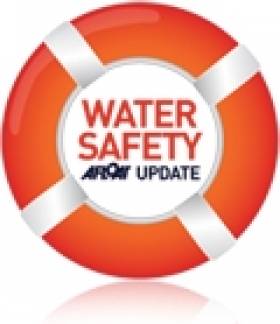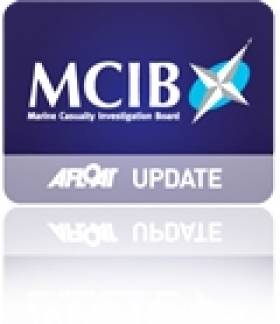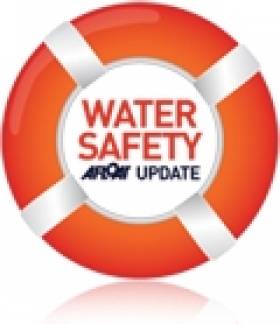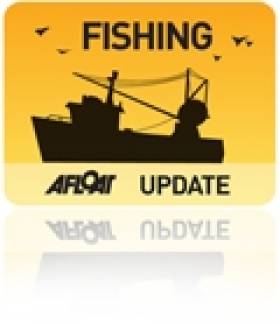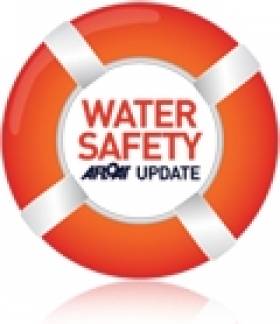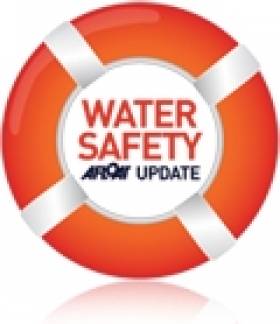Displaying items by tag: water safety
#WaterSafety - HM Coastguard has issued a safety warning over dangerous riptides along Northern Ireland's north coast this week after strong currents claimed one life and put two others at risk.
BBC News reports on the death of 25-year-old Stephen Pentony, who got into difficulty while bodyboarding off the popular surfing hotspot of Portrush in Co Antrim last Friday 16 May.
"These waters are known for rip currents," said Coleraine coastguard Chris Little, who said they "can be a very frightening experience".
Meanwhile, the Londonderry Sentinel has news of a lucky escape for two others in nearby Benone on the same day.
The two men were pulled out to sea on their personal water craft after it malfunctioned, but they managed to reach the shore with some difficulty.
One of the men was later treated in hospital.
MCIB Report On 'Flying Horse' Highlights Safety Issues
#MCIB - 'Safety first' is the message from marine investigators in their report into an incident on board a sightseeing vessel off the Skellig Islands two years ago.
The Flying Horse, a 33-foot passenger boat crewed by a single skipper, was carrying 14 passengers towards Skellig Michael on the morning of 29 June 2012 when it began taking on water after coming off a large wave.
The skipper then turned the boat around and attempted to contact the owner by mobile phone, without making any use of the vessel's VHF radio.
The passengers also have difficulty accessing the boat's lifejackets from their storage compartments, and there were not enough for all on board.
All were landed safety ashore at Ballinskelligs, Co Kerry, though they were "somewhat traumatised" by the experience.
The official report into the incident my the Marine Casualty Investigation Board (MCIB) identified a number of safety issues with the Flying Horse, not least a lack of proper instruction for donning lifejackets.
MCIB investigators identified the boat's speed before the incident to be around 18 knots, too fast for the rough seas at the time, which contributed to the hull damage that saw the boat take on water.
Moreover, no official records could be found to show that the skipper held the necessary qualifications to be the master of boat in question. or that he was in possession of a Radio Operator’s Certificate - a requirement for all passenger vessels.
The boat was also found to be technically overloaded, carrying two more passengers than allowed by its licence - not to mention "insufficient" crew for her safe operation.
The full report is available to download below.
VHF Smartphone Case Could Be A Real Lifesaver
#WaterSafety - A new case that turns a smartphone into a VHF radio could revolutionise safety on the water, as the Irish Examiner reports.
The VHF Casemate is the brainchild of Dublin-based product designer Seán Toomey, who developed the idea as his degree thesis at the Dublin Institute of Technology.
As he explains, it's a solution to the problem of boaters taking mobile phones out on the water as their only means of communication, despite poor network coverage even a short distance from the shore.
His design, which offers all a standard waterproof case provides, comes with a built-in VHF radio operated by app that also signals distress to any other vessels in the vicinity.
And it could soon be on the market, once Toomey finds a partner to help put his final design into production.
The Irish Examiner has more on the story HERE.
#WaterSafety - The crew of Bundoran RNLI's lifeboat, together with local fishermen and members of Irish Water Safety, recently welcomed a group of students from Lucan, Co Dublin who created a new school’s guide to water safety in Ireland’s rivers, lakes and seas.
The group of students from St Joseph’s College in Lucan are participating in the 2014 Young Social Innovators programme and were tasked with picking an issue of concern in their local area and to take action to change it for the better.
They decided to tackle the ongoing problem of drowning, particularly after the tragic summer last year when so many young people lost their lives needlessly during the hot spell.
Their vision for the information pack is to “think before you splash” – encouraging young people to become more involved in water activities and to increase their awareness of the water.
The pack consists of a lesson plan for teachers as well as a local ecology & water safety survey, 10 water safety rules and more.
Speaking during the visit, Bundoran RNLI crewmember Killian O’Kelly said: "It’s heartening for us who volunteer to save lives at sea to see this initiative being undertaken so enthusiastically by this group of students – they are to be commended for such an excellent piece of work and if it helps to save one life this summer then it’s time well spent."
The group hope to make the booklet available online in the coming weeks.
Donegal Firm Innovates In Water Safety With GPS Lifejackets
#Lifejackets - The Sunday Independent writes on Donegal firm Mullion Survival Technology's new innovative lifejackets that come with the latest tech to ensure help comes quickly.
The compact design sits like a collar around the user, with plenty of room for movement, but most important is the built-in GPS beacon that pinpoints the location of the user to rescuers, and a bright light that activates automatically once they hit the water.
What's more, each Mullion lifejacket is registered to a particular user, so that emergency services can know exactly who they're searching for when the alarm is raised.
Mullion's devices have already been credited with saving the life of a fisherman off Co Down, as previously reported on Afloat.ie, and as of this year will be the standard personal flotation device (PFD) for the Irish fishing fleet.
Independent.ie has more on the story HERE.
Fishermen At Greatest Risk Of Death On The Job Says HSA
#Fishing - Fishermen in Ireland have a risk of on-the-job fatality that's 40 times greater than average, as The Irish Times reports.
The shocking statistic comes with new figures from the Health and Safety Authority (HSA), which is launching a new campaign to reduce the rates of death and serious injury in the fishing sector.
This campaign will concentrate on the proper management of heath and safety before leaving port as well as safety at sea, by encouraging fishing boat skippers to carry out proper risk assessments and prepare safety statements.
Current figures show only 20% of vessels inspected last November by the HSA has completed a risk assessment, while just 30% had a safety statement.
HSA chief Martin O'Halloran said: "It’s vital that skippers and fishermen manage the very serious risks they’re facing and work to ensure that tragedy doesn’t strike their boat.” More on the story HERE.
Meanwhile, The Irish Times is also reporting on the loss of as many as 230,000 farmed fish off West Cork in one of the series of Atlantic storms that battered Ireland's coasts in the first few weeks of this year.
A site survey at an aquaculture facility run by Murphy's Irish Food in Bantry Bay found that storm damage to its mooring system and several of its cages caused the death of most of its farmed salmon.
But local anti-fish-farming campaigners Save Bantry Bay say that the damage also resulted in the "largest single salmon farm escape" in Irish history, posing a "significant genetic risk" to native wild stock.
The Irish Times has more on this story HERE.
Damages Awarded To Man Who Slipped On Rush Pier
#RushPier - "Reckless disregard" for the safety of bathers on the part of Fingal County Council was the finding of the High Court in its award of more than €59,000 in damages to a man injured in a fall at a popular North Co Dublin swimming spot.
As The Irish Times reports, 58-year-old Joseph McGrath slipped on algae on the steps of Rush pier on 27 July 2009, causing him to break his arm and twist his ankle, and putting the self-employed barber out of work for three months.
McGrath sued Fingal County Council, claiming its negligence over failing to ensure the safe condition of the pier for swimmers in the harbour.
Justice Daniel Herbert found in his favour, saying that the council knew the steps - though originally for boat access - were regularly used by swimmers, but failed to apply standard safety measures such as a installing a handrail.
The Irish Times has more on the story HERE.
Dun Laoghaire-Rathdown Recruiting Lifeguards For Summer 2014
#Lifeguards - Dun Laoghaire-Rathdown County Council is currently recruiting lifeguards for the summer season 2014.
Appointments will be made from a panel of successful candidates, each of whom must be at least 17 years of age on 13 May 2014 and must hold a current Irish Water Safety National Beach Lifeguard Qualification, Royal Life Saving Society of Ireland (RLSS) certification or equivalent as recognised by the International Lifesaving Federation (ILS).
All candidates successful at interview will be required to undergo a practical test in basic life support (BLS), swimming ability, lifesaving techniques and a theory test conducted by an examiner(s) nominated by Irish Water Safety.
Candidates successful at interview must be prepared to undergo a test in swimming under competent judges (date and venue to be decided). To assist potential candidates to achieve the Beach Lifeguard Award, the following training will be provided by:
Paul Devins with Irish Water Safety (contact 087 254 2700)
Kevin Coyle with the RLSS (contact 086 343 1793)
The wage rate is €10.61 per hour plus appropriate differentials.
Successful candidates, when offered the position of lifeguard, will be subject to Garda vetting. Please note that the Garda Vetting Form is only available in hard copy, and must be fully completed by every candidate.
The Parent/Guardian Consent Form should only be completed in respect of candidates who are under 18 years.
Application forms and full particulars of office for the above posts may be obtained from the Information Desk, County Hall, Marine Road, Dun Laoghaire, Co Dublin or Human Resources Department (Tel: 01 205 4700, Ext 4218, 4246) or from the County Council Office, Dundrum Office Park, Main Street, Dundrum, or by email to [email protected].
Completed application forms should be returned to the Human Resources Department not later than 4.30pm on Friday 7 March 2014. Candidates may be shortlisted based on the information supplied on the application forms.
Dun Laoghaire-Rathdown County Council is an equal opportunities employer.
Risky Seaside Frolics Underline Dangers Of Stormy Weather
#WaterSafety - Photographer Aidan Tarbett sent us this and other shots of a man with two young children playing in the sea spray and high winds at Bullock Harbour in Dalkey, South Dublin on Monday 3 February.
In defiance of warnings to the public by the Irish Coast Guard to avoid exposed coastal areas as Ireland continues to be assaulted by storm-force winds and heavy sea swells, this man was very lucky not to see the children swept into the harbour by the waves crashing across the pier. Scroll down for more photos in the sequence.
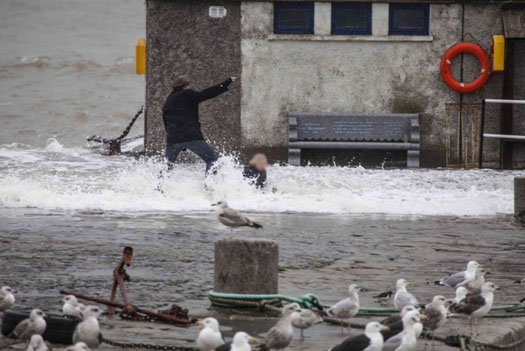

An example of what can happen when such warnings are ignored occurred last month in Howth, when a man was swept by a wave off the upper section of the North Dublin port's East Pier, injuring his ankle in the 10-foot fall to the lower level.
And just three days ago 10 people had to be rescued from a bus struck by a large wave on the seafront in the Welsh town of Newgale.
Water Safety Warnings Repeated After Man Caught By Wave In Howth
#WaterSafety - The public has been reminded yet again to stay away from the water's edge as the country continues to be battered by huge waves and storm-force winds after a man was injured on Howth's East Pier this afternoon (6 January).
As TheJournal.ie reports, the man was caught by a wave while walking along the upper portion of the North Dublin pier and thrown some 10 feet to the lower section, injuring his ankle in the fall.
The man has ventured onto the wave-lashed pier despite widespread warnings to the public from the Irish Coast Guard and Irish Water Safety to keep a good distance from the water during this latest orange alert weather warning from Met Éireann.
Coastguard chiefs have reiterated last week's appeal by Irish Water Safety for people to stay away from waterside areas until the current series of storms and high tides has passed.
Last week Waterways Ireland also warned of the dangers posed by rising tides in inland harbours and waterside areas as flooding persists in various spots nationwide.


























